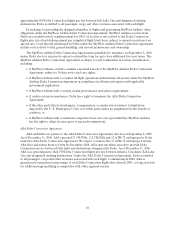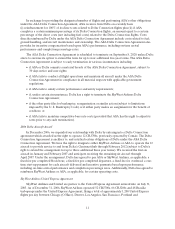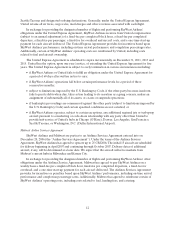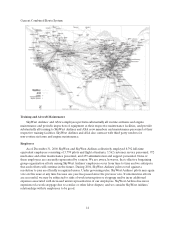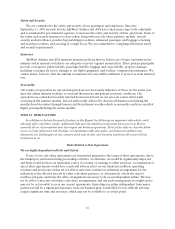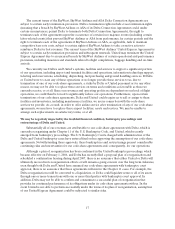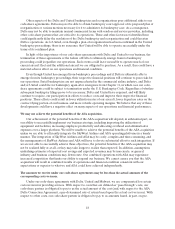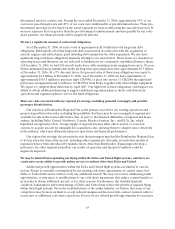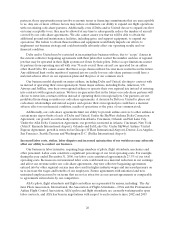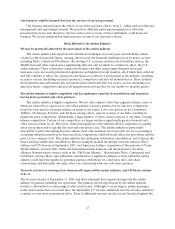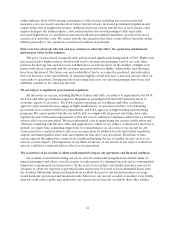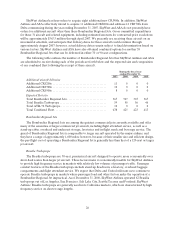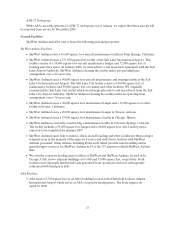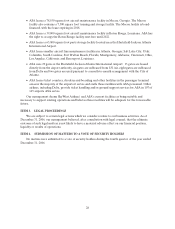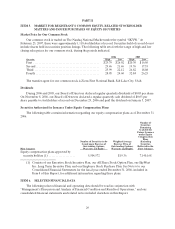SkyWest Airlines 2006 Annual Report Download - page 25
Download and view the complete annual report
Please find page 25 of the 2006 SkyWest Airlines annual report below. You can navigate through the pages in the report by either clicking on the pages listed below, or by using the keyword search tool below to find specific information within the annual report.19
determined ratesfor certain costs. During the yearended December 31,2006, approximately 55% of our
costs were pass-through costs and 45% of our costs were reimbursable at pre-determined rates. These pre-
determined rates may not be based on the actual expensesweincur in deliveringthe associated services. If
we incur expenses that are greater than the pre-determined reimbursement amounts payable by our code-
sharepartners, our financial results will be negatively affected.
We have a significant amount of contractual obligations.
As of December 31,2006, we hadatotal of approximately$1.8 billion in total long-termdebt
obligations. Substantially all of this long-term debt was incurredin connection with theacquisition of
aircraft, engines and related spare partsincluding debt assumed in the ASA acquisition. We also have
significant long-termlease obligations primarily relating to our aircraft fleet. These leases are classified as
operating leases and therefore are notreflected as liabilities in our condensed consolidated balancesheets.
At December 31, 2006, we had268 aircraft under lease, with remaining terms rangingfrom one to 18 years.
Future minimum lease payments dueunder all long-term operating leases were approximately $3.5 billion
at December 31, 2006.At a7% discountfactor, the present value of these lease obligations was equal to
approximately $2.2billion at December 31,2006. As of December 31,2006, we had commitments of
approximately $363.5 millionto purchase eight CRJ900s, to place into service 11 CRJ200sthrough third-
partylease arrangements and to sublease 12 CRJ700’s from Delta,togetherwithrelatedflight equipment.
We expect to completethese deliveries by April 2007. Our high level of fixed obligations could impact our
ability to obtain additional financing to support additional expansion plansor divert cash flows from
operations and expansion plansto service thefixed obligations.
There are risks associated with our regional jet strategy, including potential oversupply and possible
passenger dissatisfaction.
Our selection of Bombardier Regional Jets as the primary aircraft for our existingoperations and
projectedgrowth involvesrisks, including the possibility thatthere may be an oversupplyofregionaljets
availablefor salein theforeseeable future, due, in part, to the financial difficulties of regional and major
airlines, including Delta, United, Northwest, Comair, Mesaba Aviation,Inc., and FLYi, Inc. which
liquidated its regional jetfleet.A large supply of regional jets mayallowother carriers, or even new
carriers, to acquire aircraft for unusually low acquisition costs, allowing them to compete more effectively
in theindustry, which may ultimately harm our operations andfinancial performance.
Our regional jet strategy also presents the risk that passengersmay find the Bombardier Regional Jets
to be less attractive than other aircraft, including other regional jets. Recently,several other models of
regional jets have been introduced by manufacturers other than Bombardier. If passengers develop a
preference for other regional jet models, our results of operation and financial condition couldbe
negatively impacted.
We may be limited from expandingour flying within the Deltaand United flight systems, and there are
constraints on our ability to provide airline services to airlines other than Deltaand United.
Additional growth opportunities within the Delta and United flight systems are limited by various
factors. Exceptas currently contemplated by ourexistingcode-share agreements, we cannot assure that
Delta or United will contract with us to fly any additional aircraft. We may not receive additional growth
opportunities, or may agree to modifications to our code-shareagreements thatreduce certain benefits to
us in order to obtain additional aircraft, or for other reasons.Furthermore, the troubled financial
condition, bankruptcies and restructurings of Delta and United mayreduce the growth of regional flying
within their flight systems. Given thetroubled nature of the airline industry, we believe that some of our
competitors may be more inclined to accept reduced margins and less favorablecontract terms in order to
secure new or additional code-share operations. Even if we are offered growth opportunities by our major



